An Illustrated History of Old Sutton in St Helens, Lancashire
Part 30 (of 95 parts) - Sport in Sutton (St Helens)
Researched & Written by Stephen Wainwright ©MMXX Contact Me
Researched & Written by Stephen Wainwright ©MMXX
Old Sutton in St Helens

An odd report from the Liverpool Mercury of 1/5/1899. How did Wavertree win by 4 runs after batting second and losing all 10 wickets?

Sutton CC scorecard in the Liverpool Mercury of May 1st 1899

Liverpool Mercury of May 1st 1899
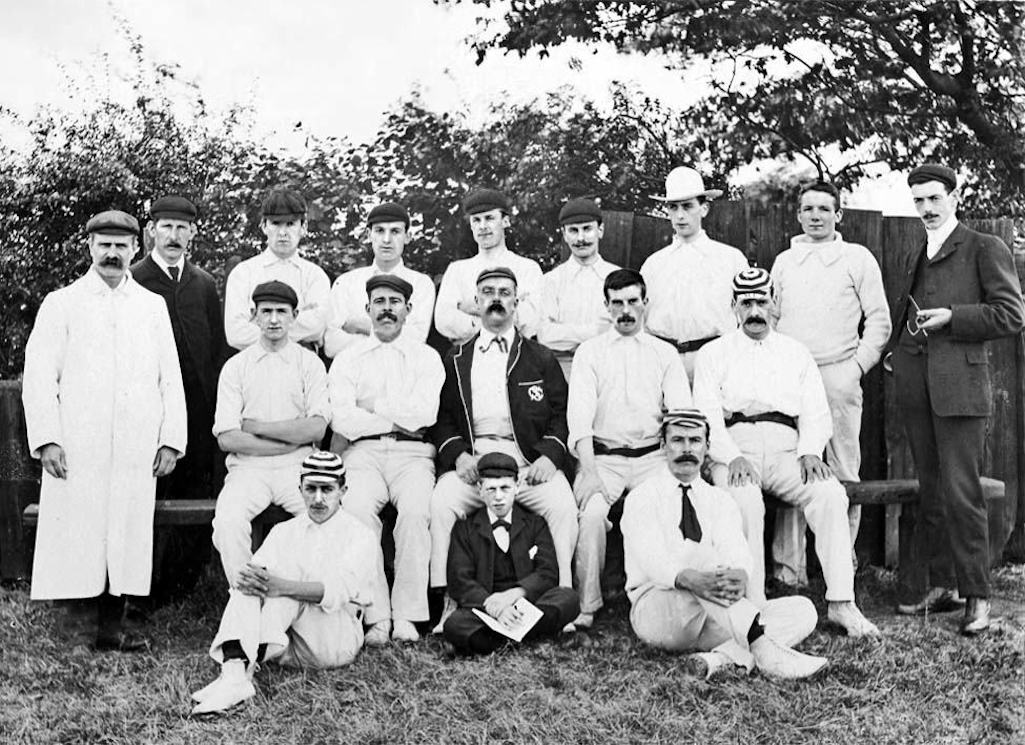
Sutton Cricket Club team c. 1898 to 1900 when based at Normans (Hoghton) Road - contributed by Frank Parry

Sutton Cricket Club team c.1898 to 1900 when based at Normans Road

Sutton Cricket Club team c.1900
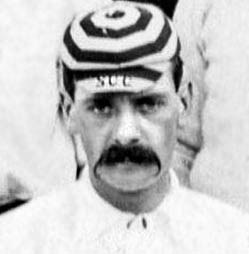
Hughes was patron of the team and paid all the removal expenses from Hoghton Road and had the wicket transferred and relaid. The club were allowed the use of his land for a pepper-corn rent of a pound per year. The owner of Sherdley Hall blocked proposals to build houses in front of the cricket field and sometimes would bring teams of gentlemen players to play Sutton CC. In 1937 Hughes sold the club the land in New Street for just £300, which was a fraction of its true value.
In fact chief Sutton landowner Michael Hughes was a great supporter and benefactor of sport in Sutton and was president or chairman of more than 30 sporting clubs in the district. Although on July 1st 1907 he resigned all his positions in protest at the Workmen's Compensation Act. Hughes also owned as many as 60 racehorses during his lifetime, who were often seen being trained in Sherdley Park during the close season.
The sound of leather on willow ceased in Sutton during the First World War. The ground was instead used for growing produce, although the 22 yards of pitch was spared the spade! Benny Morris was a well known scorer at Sutton Cricket Club during the early years of the 20th century. Benny lived in Lee Street and worked as a moulder at Allan Barton's factory.
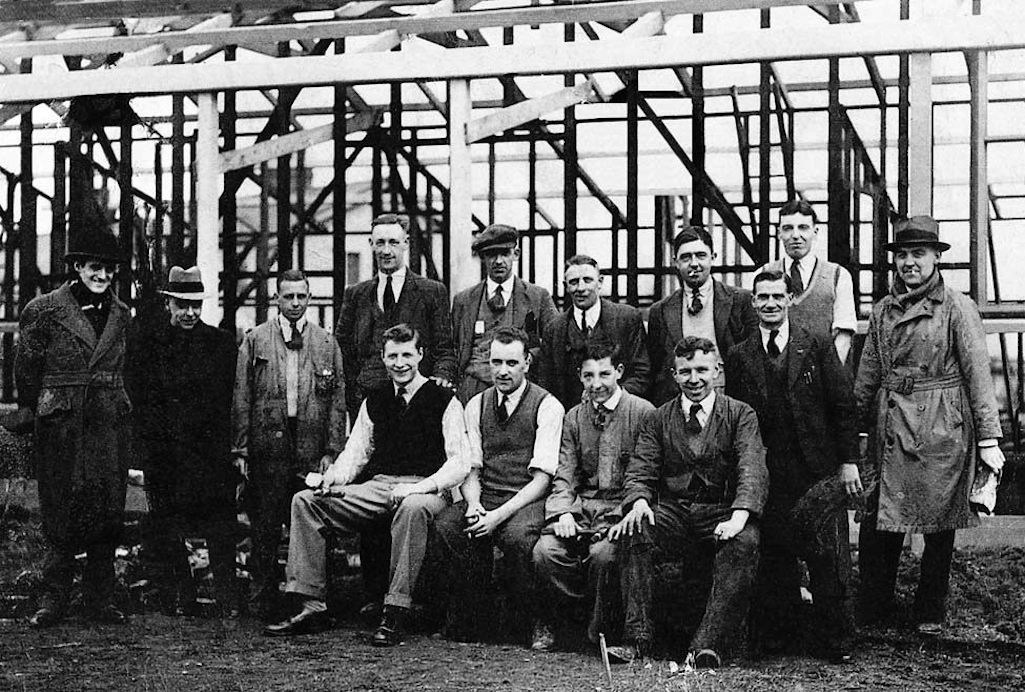
The building of a new pavilion at Sutton Cricket Club in New Street contributed by Marjorie Hall

The building of a new pavilion at Sutton Cricket Club in New Street

Building of a new pavilion at the club
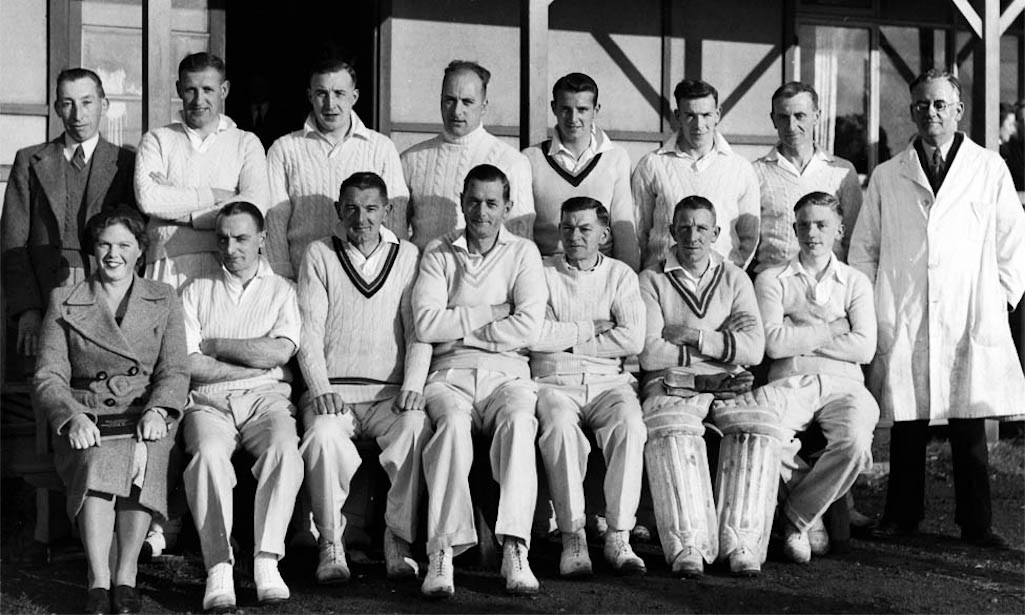
Sutton Cricket Club’s 1st team pictured in 1943 - Contributed by Geoff Chisnall - View Version With Names

Sutton CC 1st team pictured in 1943 - View Version With Names

Sutton CC 1st team in 1943
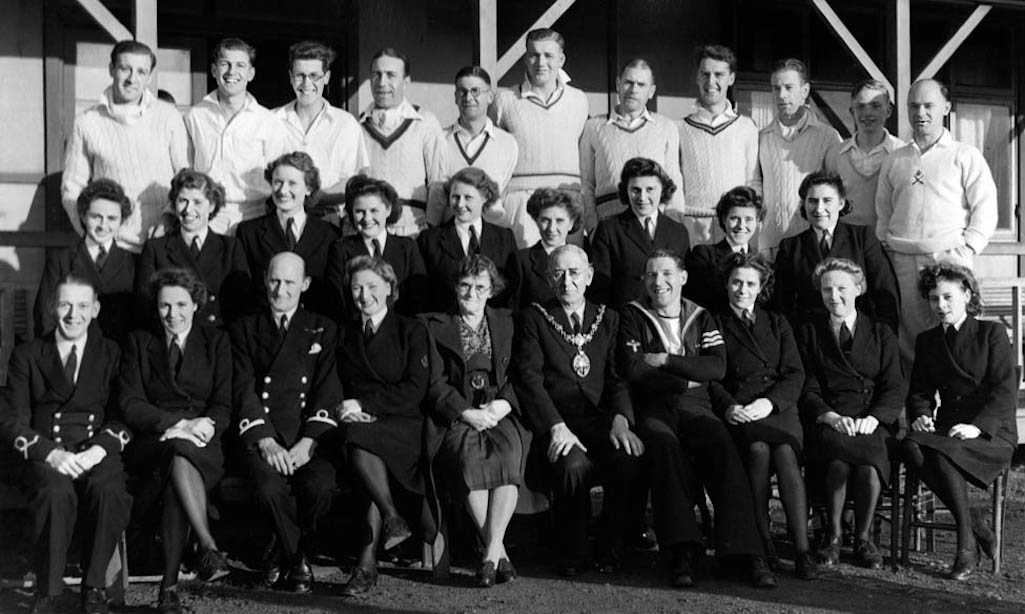
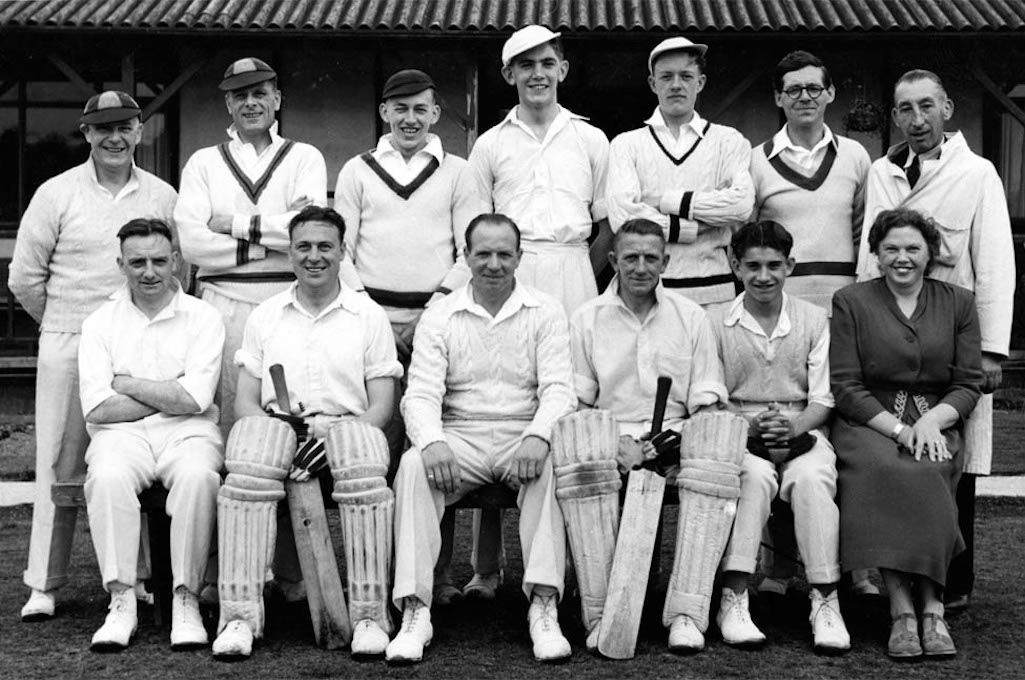
Sutton Cricket Club second X1 pictured at their New Street ground in 1950 - Contributed by Geoff Chisnall

Sutton Cricket Club second X1 at their New Street ground in 1950

Sutton Cricket Club 2nd X1 in 1950
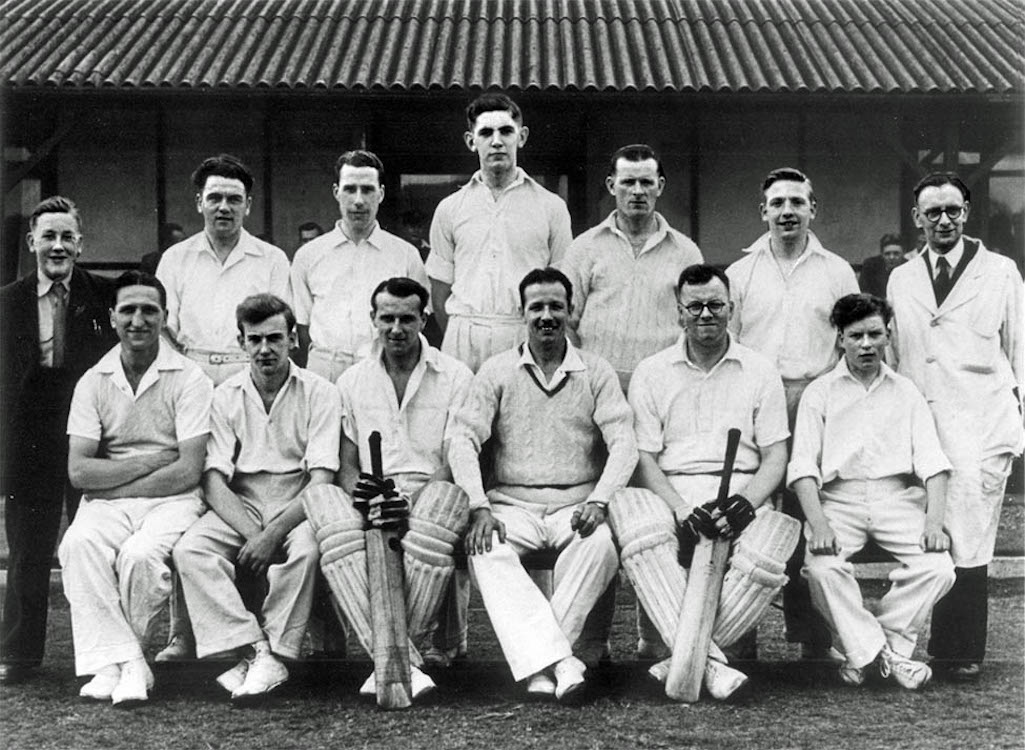
Sutton Cricket Club 1st team pictured at their New Street ground c.1951 - Contributed by Geoff Chisnall

Sutton Cricket Club 1st team pictured at their New Street ground c.1951

Sutton Cricket Club 1st team c.1951
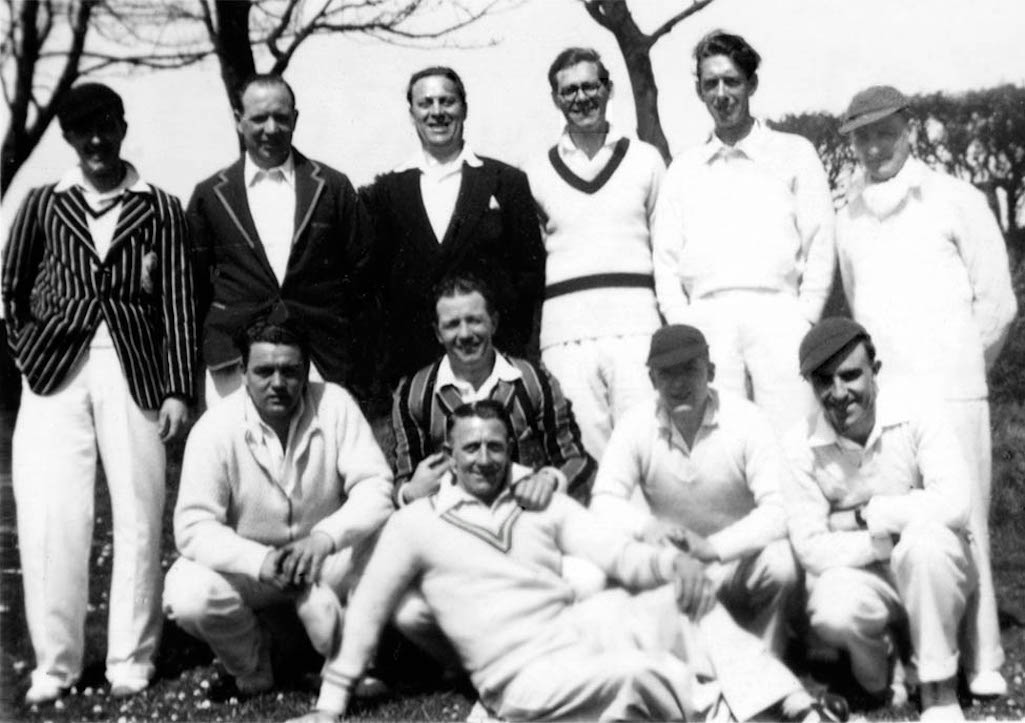
Sutton CC in Nobles Park on a tour of the Isle of Man in 1951 - Contributed by Geoff Chisnall

Sutton Cricket Club in Nobles Park on tour in the Isle of Man in 1951

Sutton CC in the Isle of Man in 1951

Basil D'Oliveira shakes hands with Glynne Perry, captain of Sutton Cricket Club, in September 1989

Basil D'Oliveira shakes hands with Glynne Perry, captain of SCC, in 1989

Basil D'Oliveira shakes hands with Glynne Perry, captain of SCC in 1989
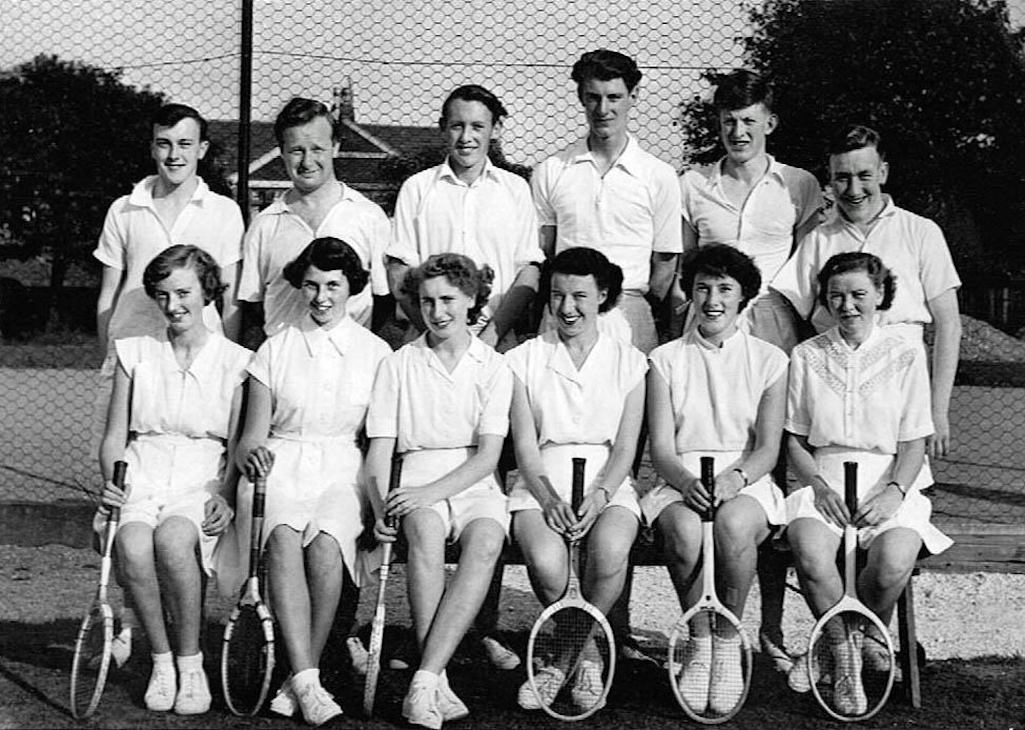
Sutton Cricket Club's early 1950s tennis team. Front Row Left to Right: Jennifer Rhodes; Barbara Williams; M.Coats; Miss Brown; ?; Miss Heaton; Back Row: Geoff Weaver; Fred Naylor; Morris Downton; Ted Heward; Ian Shaw; Roy Haycock

Sutton Cricket Club's early 1950s tennis team who played at New Street

Sutton CC 1950s tennis team
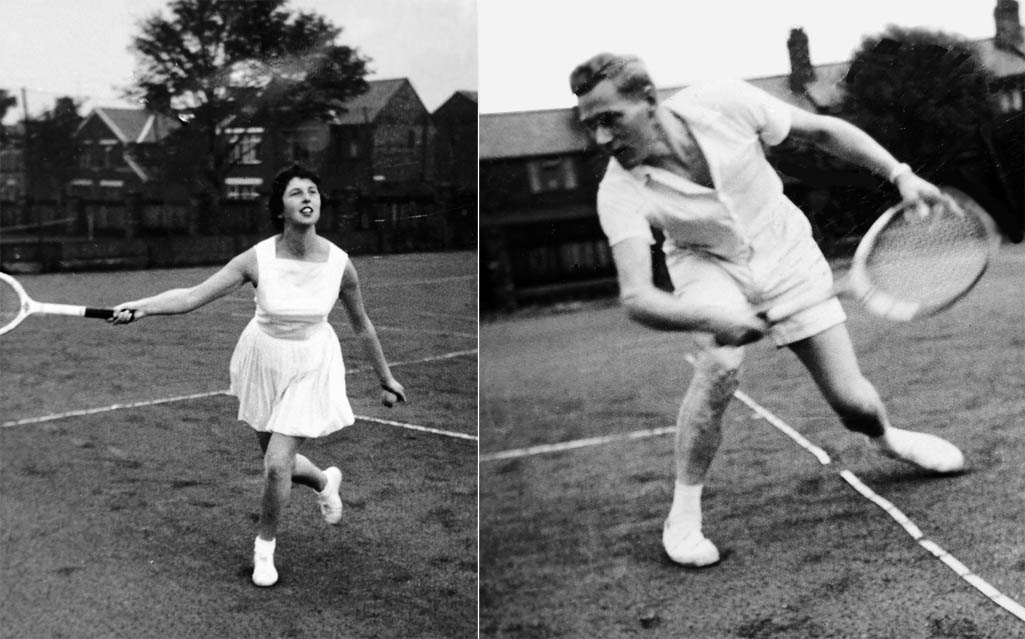
Barbara Williams and Tony White of Sutton Cricket Club’s Tennis Club pictured around 1960

Barbara Williams and Tony White of Sutton Tennis Club c.1960

Barbara Williams and Tony White
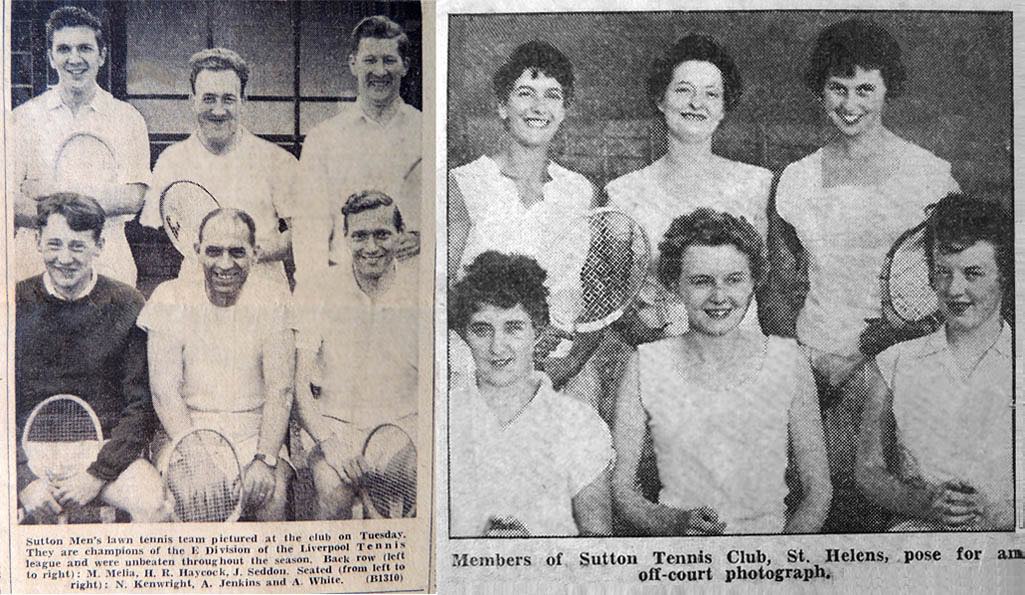
Cuttings from 1959 and 1961 - the latter included Rita Woodward, Margery Seddon, Barbara Williams & Irene Chadwick

Sutton Tennis Club newspaper cuttings from 1959 and 1961

Tennis club cuttings from 1959 and 1961
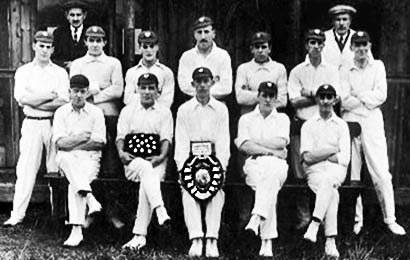
Athletics events during the nineteenth century were mainly footraces where much money changed hands and with Bold Heath a popular venue. Two athletes called Heyes and Rigbye competed at Bold Heath on November 5th 1859 in front of hundreds of people, despite heavy rain. The Liverpool Mercury reported how on June 1st 1863, 'young Lyon of Sutton' had taken on a celebrity runner from St.Helens called Daw Critchley 'for £5 a side'. Many of the local sporting celebrities were present to watch the one mile race on Bold Heath which was won by Lyon by ten yards.
In 1882 the London & N. W. Railway began the first of their annual athletics festivals, which were held on their Recreation Ground at St.Helens Junction. This was connected with the Recreation Club of the Sheeting Sheds and Stores and in 1889 the ground was extended to 4 acres and re-laid and a new running track installed. A brick and stone pavilion was erected at a cost of £600, which also served as a club for railway employees.
The athletics event of 1889 was not without incident as a bicycle crash had a domino effect, causing three more cyclists to come to grief, with one rider being badly injured. The many bookmakers on the ground also led to accusations of corruption, with one contestant accused of throwing a race.
Sutton Harriers were formed in 1899 and they are the fourth oldest athletics club in Merseyside (although now known as St Helens-Sutton Athletic Club after a merger in 1990). From the outset they were remarkably successful. Within seven years of their formation, they'd won 13 sets of medals from 14 competitive championships, as well as the National Cross Country Championship. Inevitably Colonel Michael Hughes was their patron and was said to be extremely proud of their achievements.
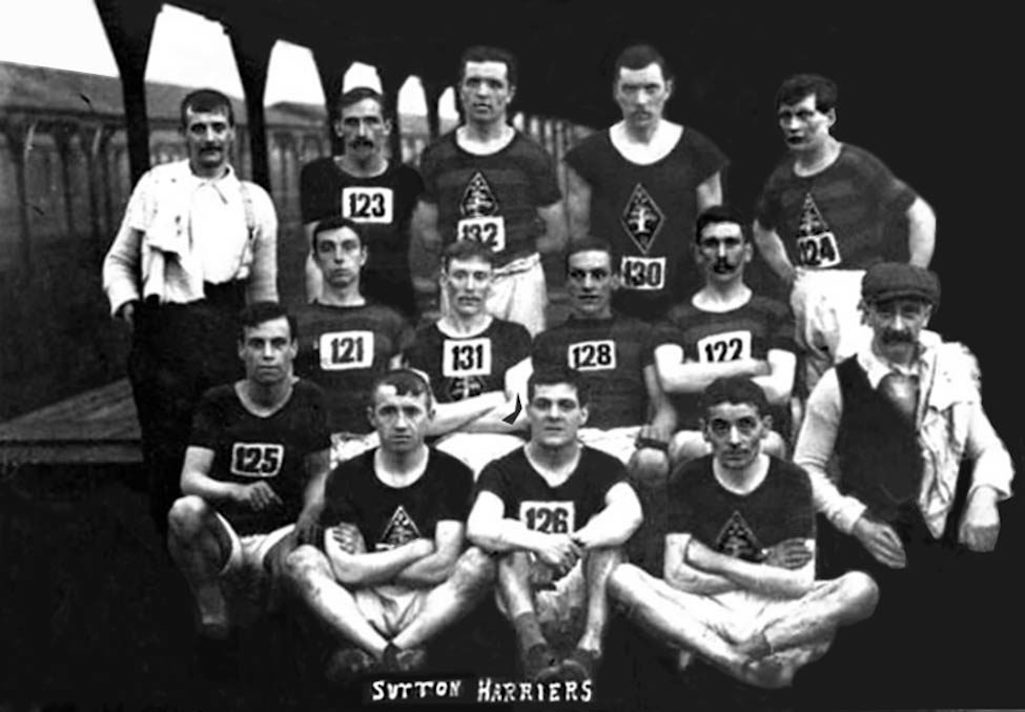
Sutton Harriers Athletics Club were founded in 1899 and are photographed around 1910

Sutton Harriers Athletics Club were founded in 1899 and are pictured c.1910

Sutton Harriers Athletics Club c.1910
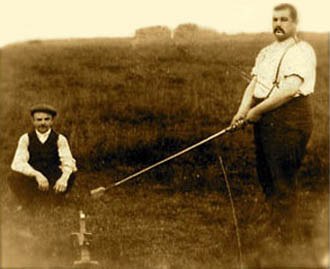
During the twentieth century, organised boxing increased in popularity with Ernie Proudlove, George 'Bold' Thomas, Mick Gordon, Wilf Douglas, Jack Gutteridge and Ray Shiel all popular pugilists who were based in Sutton and Clock Face. Then there was Ike Beech and his son Billy, who were the wrestling stars from Sutton Manor. (See dedicated Sutton Boxers & Wrestlers page)
Sutton miners also played Knurr and Spell. The Knurr was a hard ball which was propelled vertically into the air by a Spell, a mechanical device that was tripped when a foot or club pressed a lever. Other sporting activities included playing 'piggy', attending Newton races, bowling, whippet racing, rabbit coursing and starling shooting.
Pigeon-flying had its enthusiasts and there used to be a Sutton Oak Homing Society. Short scotching was the name for short pigeon racing in Sutton over one to two miles using specially trained birds. Each competitor had his own umpire who ensured that the pigeons were released at the correct time. A second man at the pigeon loft recorded the bird's time of arrival. Pitch-and-toss of penny coins was endemic and pounds were staked on every toss. The practice was illegal and the police were regularly on the look out for offenders. (See 'The Raid On The Sutton 'Tossers' article)
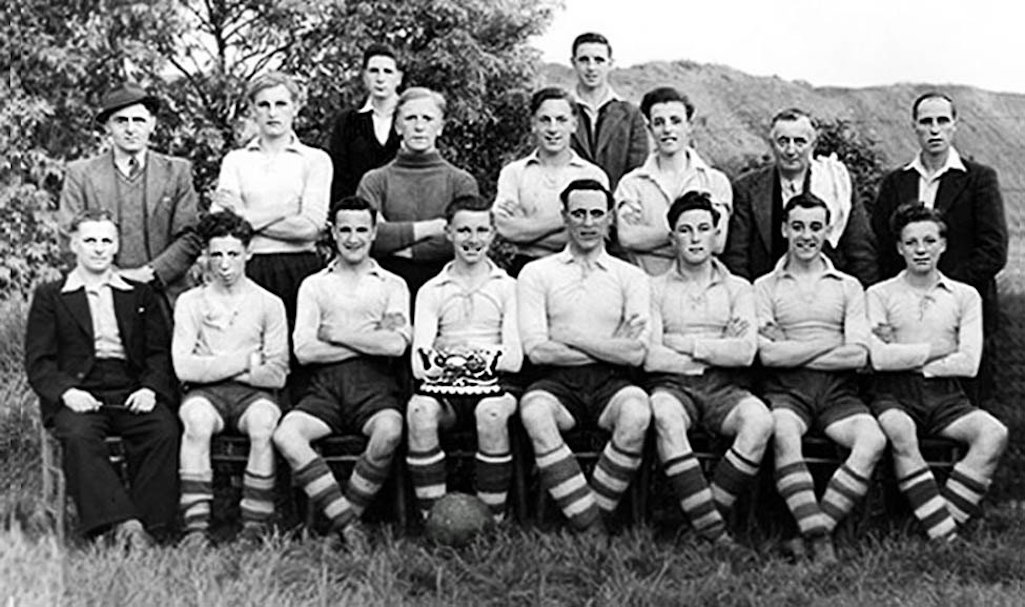
Sutton Manor Colliery’s 16-18 year football team pictured in 1949 with the E.K. Lawrenson Memorial Rose Bowl. On the front row far right is Walter Johnson. Third from end on right is Norman Kerfoot. On back row third from right is Gordon Rowley.

Sutton Manor Colliery 16-18 team with E.K. Lawrenson Memorial Rose Bowl

Sutton Manor Colliery 16-18 team
Sutton FC played rugby, as opposed to association football, and for four years from 1888 had a rising star in Jimmy Rennie (c.1871 - 1892). He lived at 25 Chester Lane and like his father Joseph, was a miner at Lea Green colliery. Earlier in the 1891/2 season, 21-year-old James had been transferred to St.Helens Football Club, which would become the successful Saints Rugby League side. He scored five tries in the short time that he spent with the club before his back was broken in a mining accident.
A large stone detached itself from the roof inside Lea Green's Potato Delph mine on April 7th 1892 and crushed Rennie. The club paid for an expert surgeon to travel to the Cottage Hospital in Peasley Cross to perform an operation, but he was too severely injured and died a few days later. The St.Helens Newspaper (18/4/1892) said he was ‘one of the most promising players in the forward rank’ and the Liverpool Mercury (20/4/1892) reported that his funeral at St.Nicholas Church, Sutton had ‘a very large attendance of sympathising friends. The Ravenhead Brass Band headed the cortege, and in the procession were members of all the St.Helens football clubs’.
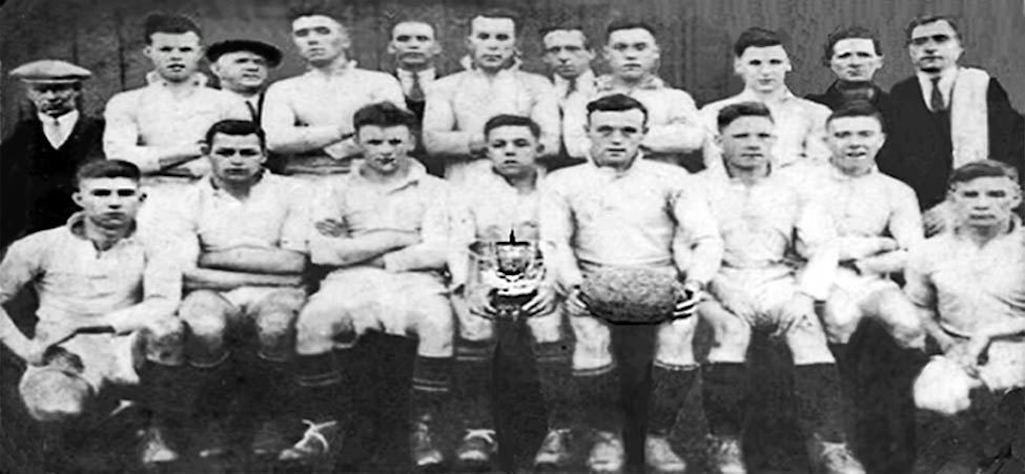
Sutton Commercial Rugby League team with the Warrington Observer Cup pictured during the 1920s

Sutton Commercial Rugby League team pictured during the 1920s

Sutton Commercial Rugby League team
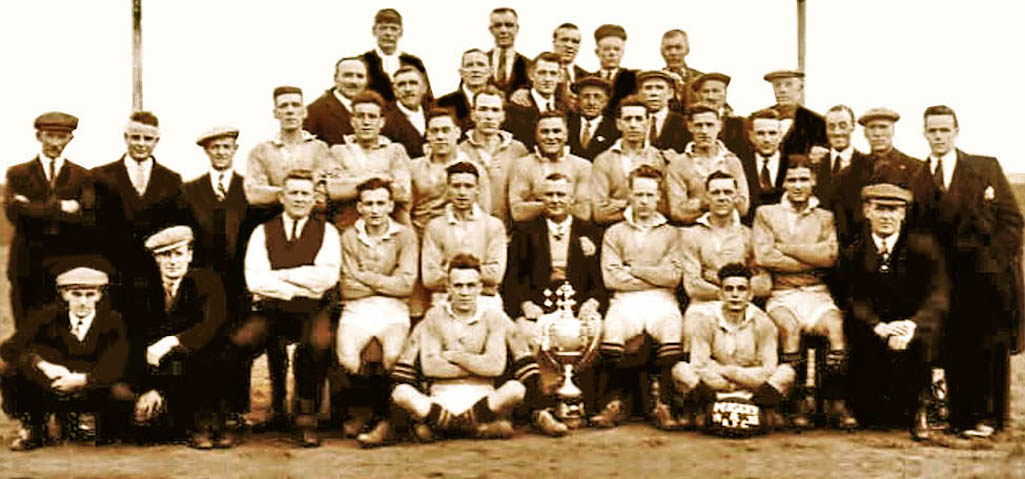
The cup-winning Peasley Cross Rugby Club team pictured here in 1933

The cup-winning Peasley Cross Rugby Club pictured in 1933

Peasley Cross Rugby Club in 1933
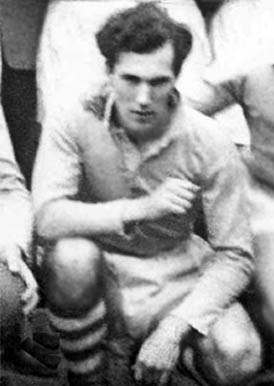
Mick worked at Clock Face Colliery as a trainee mining surveyor before qualifying as a consultant engineer. These were the days when players had other jobs and Mick decided to leave Warrington's rugby league side in 1952 to concentrate on his non-sporting career. He probably didn't regret his decision as his work on the tunnel at Liverpool Central Station led to him being presented to the Queen. Mick moved to Thailand in 1963 and died in South Wales in 2010 aged eighty-one. Also born in Sutton Manor was Frank Kitchen, who played rugby league for Leigh during the 1950s and also made a name for himself in crown green bowing.
The St.Helens Combination associated football league was originally formed in Sutton on August 4th 1917, when Ernest Worrall of 92 Waterdale Crescent called a meeting in the old LMS Club in Penlake Lane (later the British Rail Club). It was originally known as the St.Helens Junior Football League with two divisions. One was intended for players around 17 years of age and the other had an open age.
The inaugural teams included St Helens Junction, Sutton Manor Colliery, Peasley Cross Juniors, Clock Face, Ravenhead St. John's, Allen Barton's and Sutton Rovers. The latter were a highly successful exponent of the 11-a-side game during much of the 20th century. In the photograph below, taken at the end of the 1925-26 season, the team are pictured in Ellen Street. The East Sutton Labour Club, then a wooden building, is in the background. Jed Rattigan of Berrys Lane is seated third from the right on the front row.
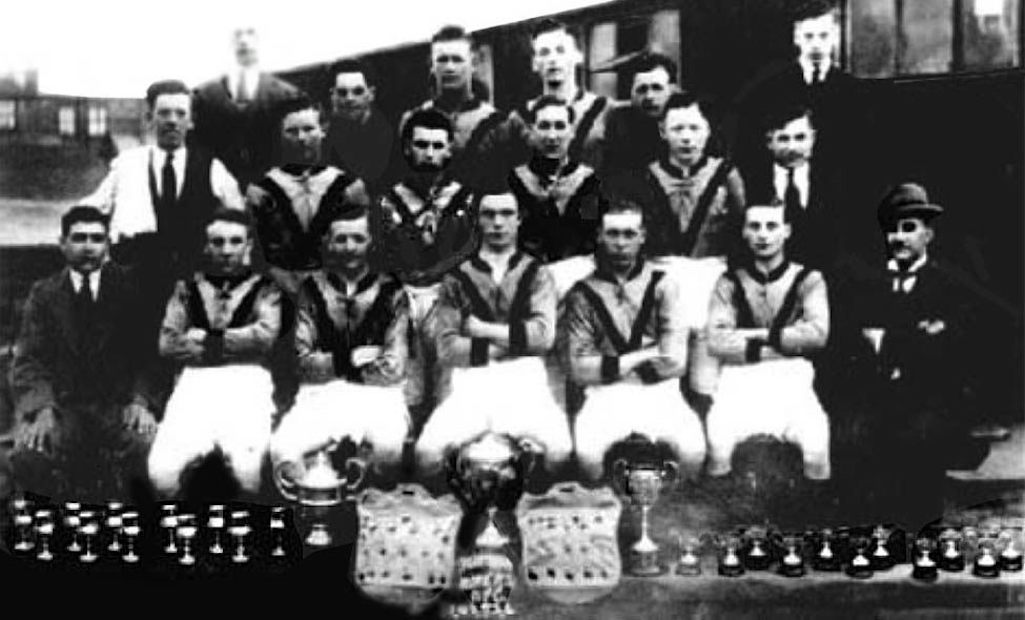
Sutton Rovers Football Club show off their silverware in Ellen Street in Sutton about 1926

Sutton Rovers F.C. show off their silverware in Ellen Street c.1926

Sutton Rovers F.C. about 1926
Friar formed a consortium with a number of businessmen and bought from Pilkingtons the land at Hoghton Road that had formerly been the home of Sutton Cricket Club. The adjacent Bold Colliery supplied the materials that were used to construct changing rooms and refreshment huts and St.Helens Town were accepted into the Liverpool Combination.
Jack Friar was club secretary and George Fryer was the ambitious manager of the team. A timber structure from RAF Haydock was converted into a supporters' social club and a stand was built at the ground to seat 200 spectators, as part of a total ground capacity of 10,000.

Two St.Helens Town team photos with goalkeeper Bert Trautmann (1923 - 2013) from 1948 and February 1949

Two St.Helens Town team photographs with goalkeeper Bert Trautmann

St.Helens Town team photographs
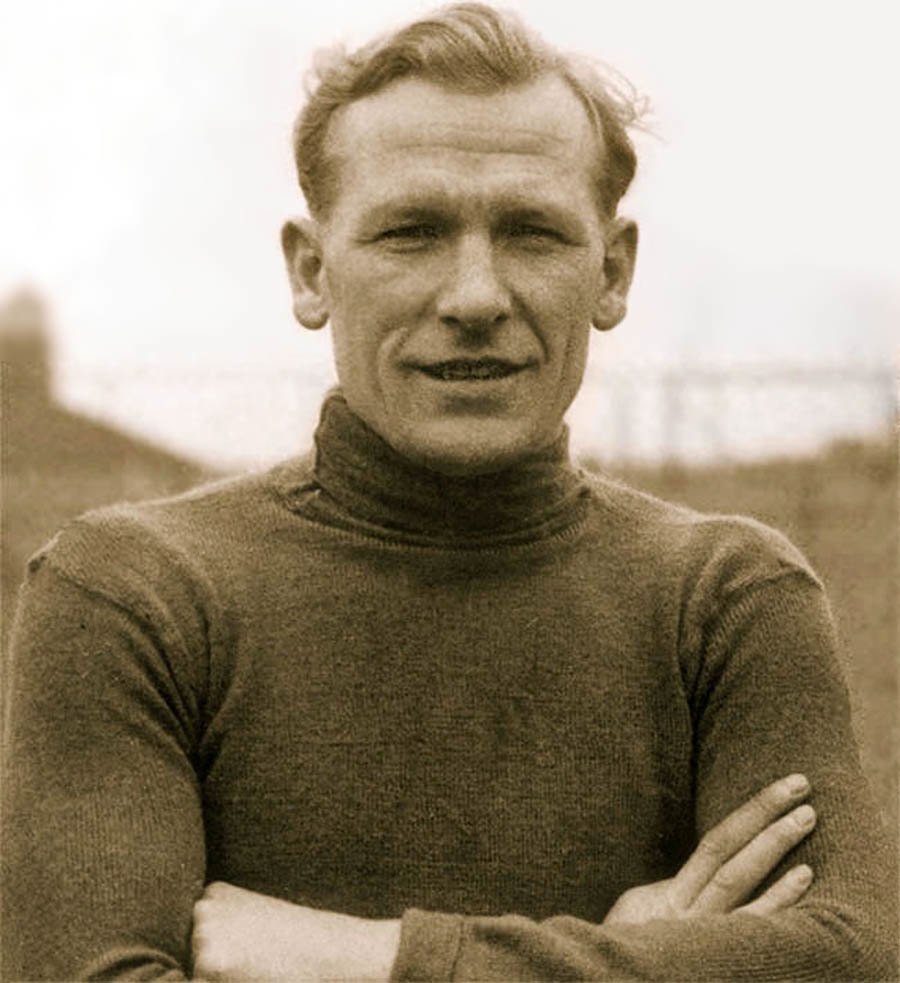
Bert Trautmann pictured in 1954 when playing for Manchester City under Don Revie

Bert Trautmann pictured in 1954 when playing for Manchester City

Bert Trautmann in 1954 when playing for Manchester City under Don Revie
During that month he was also granted leave from the government to return home to Bremen, so he could see his family for the first time in seven years. The German goal-stopper took with him a large, heavy trunk weighing almost five stones which was packed with foodstuffs that the St Helens Town's supporters club had presented to him in a Sutton cafe. They'd sacrificed their own ration coupons to help Bert's family in Bremen. The fans had also given a tearful Trautmann an envelope containing 150 one-pound notes. A small fortune in those days and it was a gesture that he's never forgotten.
Speaking in 2009, 86-year-old Trautmann, who used to drink in the Junction Inn, commented to the St.Helens Star on the time that he spent in Sutton:
A persistent Jock Thompson, manager of the Maine Road club, was at his bedside for almost four hours and Bert told Barbara that he'd only signed the contract as he was desperate to go to the toilet! City signed the player behind the back of Friar, who was at a meeting in Manchester, and they also beat Burnley to the signature of the German goalie. The Clarets had agreed to Friar's request to make a 'donation' to St.Helens Town in lieu of a transfer fee. Being on amateur forms, no fee was permissible, but there was nothing to prevent a gift to the club. However, St.Helens Town received nothing from Manchester City, apart from a verbal agreement to hold friendly games between the two sides, for which the 'Sky Blues' contributed under-strength teams.
Although the pressured signing was considered controversial in St Helens, it was hugely so in Manchester, especially amongst members of the large Jewish community. The invective was so strong that at one point Trautmann was quoted as saying that he wished he'd stayed in St.Helens. The Luftwaffe sergeant, who'd been awarded the Iron Cross, had been used to tolerance, kindness and even hero-worship in Sutton - not hatred. In Catrine Clay's 2010 biography, 'Trautmann's Journey – From Hitler Youth to FA Cup Legend', the author paints him as having been a loyal Third Reich supporter, who was far from being a good, innocent German who'd been accidentally caught up in the war.
So the hostility to his signing was fully understandable. However, Bert continued living at 106 Marshalls Cross Road for a further nine months and with the support of the Friar family, club management and other players, soon won over the City fans. His marriage to Margaret Friar, the daughter of Jack, took place in March 1950 in St.Helens and their son John Michael was born during the following October.
On May 3rd 1956, the ex-German paratrooper became the first goalkeeper to be awarded the Football Writers’ Association Footballer of the Year. Two days later in the FA Cup final against Birmingham City, Trautmann broke his neck but continued in goal despite terrible pain. This was in an era when substitutes were not allowed and Bert's bravery for the final seventeen minutes of the game, allowed Manchester City to win the cup.
However, within three weeks, triumph turned to tragedy for Trautmann as his five-year-old son John was killed in a road accident in Bramhall, near Stockport. The young boy had dashed out from behind a mobile sweets van and was knocked down by a car. John's funeral took place at St.George's church in Stockport, with his burial in Sutton at St. Nicholas church. A large crowd gathered in New Street to pay their own respects and as the burial took place at lunchtime, many Sutton schoolchildren took the opportunity to watch the proceedings.
Trautmann ended up playing 545 games for the Sky Blues and after retiring from playing in 1964, began a managerial career at Stockport County. The Bremen-born goal-stopper saw out his days in Valencia in Spain, dying in 2013 at the age of 89.
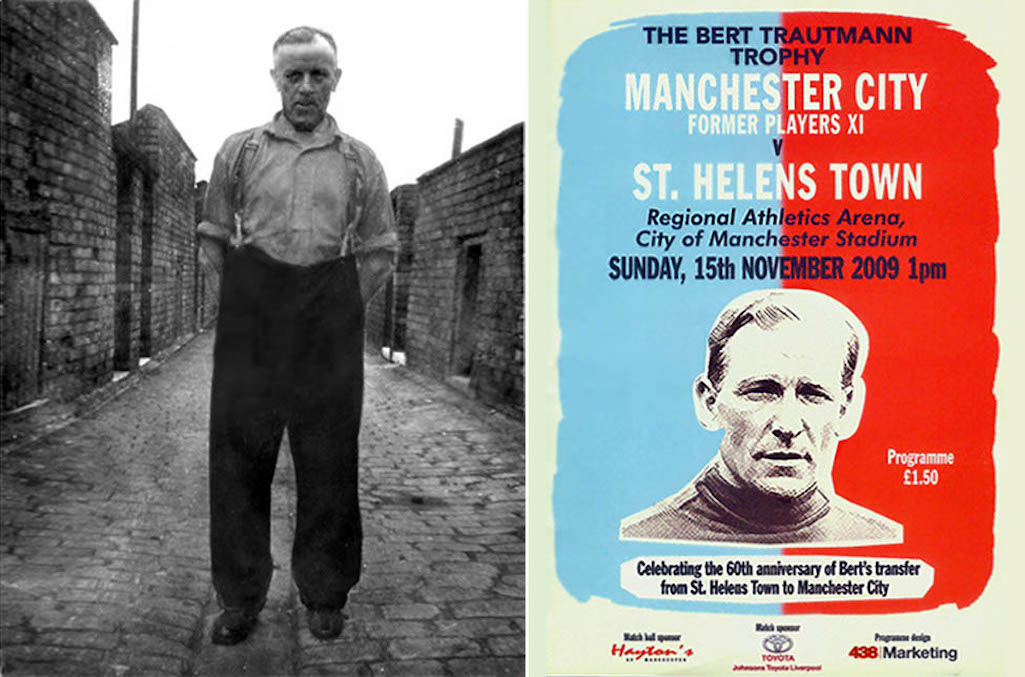
Left: Dick Kitts in 1947 contributed by George Houghton; Right: St.Helens Town vs. Manchester City programme

Dick Kitts in 1947 and St.Helens Town vs. Manchester City programme

Dick Kitts in 1947 and St.Helens Town vs. Manchester City programme
On Sunday November 15th 2009, St Helens Town played a Manchester City Former Players XI for the Bert Trautmann Trophy which they won 6-5. The match commemorated the 60th anniversary of Bert's transfer, although Town's Honorary President, then resident in Spain, was unable to attend through ill health.
The club had left Hoghton Road in Sutton nine years earlier for Saints old Knowsley Road ground, which they vacated in 2010 for grounds in Ashton and Atherton. St.Helens Town are currently in the first division of the Hallmark Security League and will be returning to St.Helens in September 2016, when they will be playing home games at the revamped Ruskin Drive.
Bert Trautmann died at his home near Valencia on July 19th 2013. A special memorial charity game between St Helens Town and Manchester City took place at Prescot Cables' Valerie Park ground on November 17th. This was attended by members of Bert's family and supported by former team mates from both clubs.
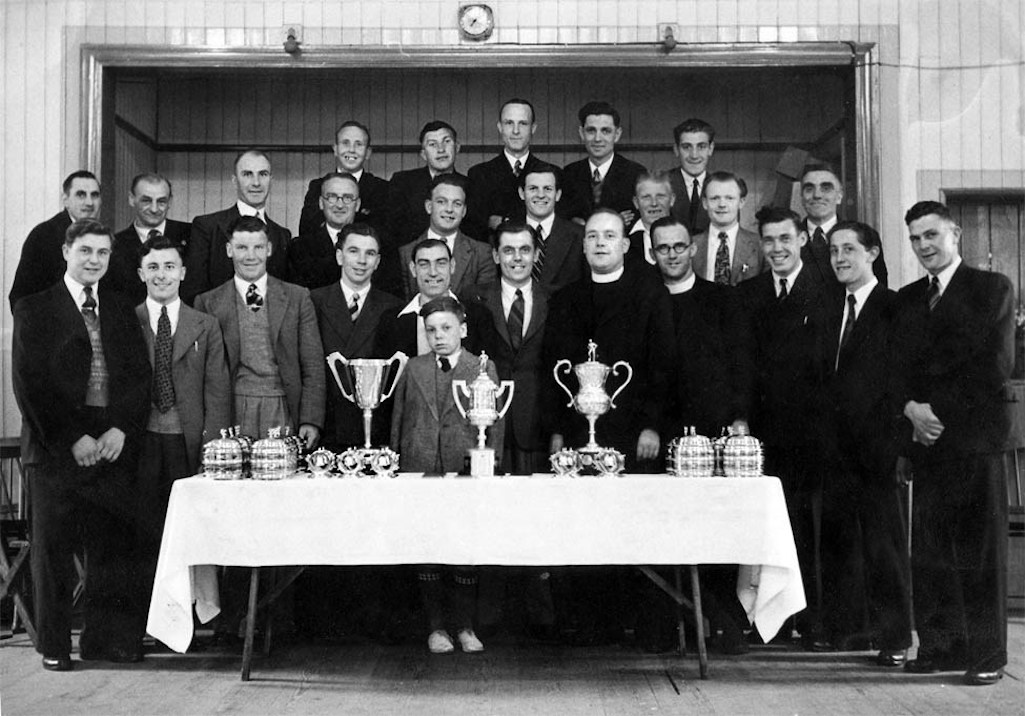
St.Anne's FC probably 1947-8 season. On front row is Alfred Smith (4th from left) & Joe Grice (5th left) & Alan Kendrick (2nd right)

St.Anne's FC thought to be taken at the end of the 1947-8 season

St.Anne's FC probably 1947-8 season
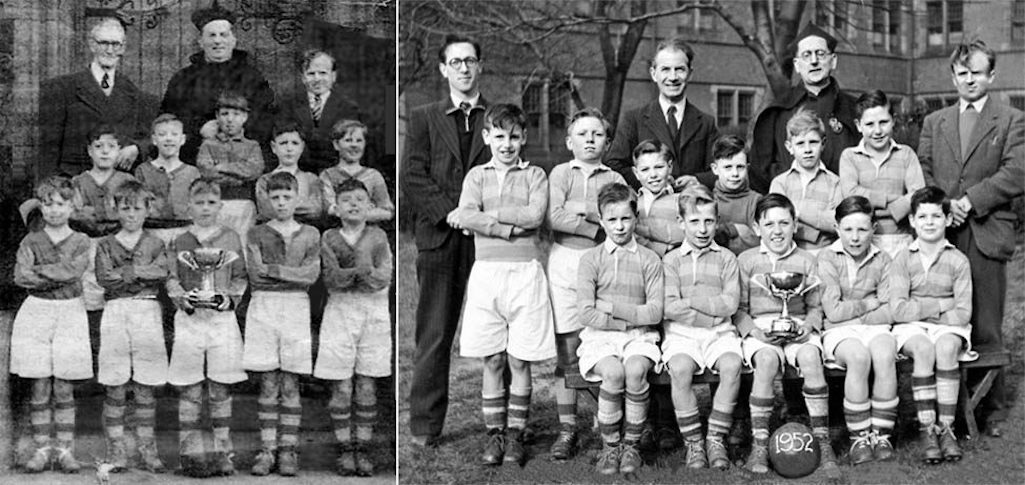
Left: St.Anne's 1950 under 11s football team with the Junior Schools Trophy held by Walter Noonan. The longstanding headmaster John Duffy stands next to priest Fr. Jeremias with teacher William Bold standing on the right; Right: St.Annes 1952

St.Anne's 1950 U11s team with Junior Schools Trophy and St.Annes in 1952

Left: St.Anne's 1950 U11s with Junior Schools Trophy; Right: St.Annes 1952
In 265 appearances for Burnley as a winger, he scored a remarkable 105 goals and in 1964 he transferred to Manchester United who paid £56,000 for him. Connelly received 20 international caps and was in England's 1966 World Cup-winning squad but only played in the opening game against Uruguay. He was an unused reserve in the celebrated 4-2 final win over West Germany.
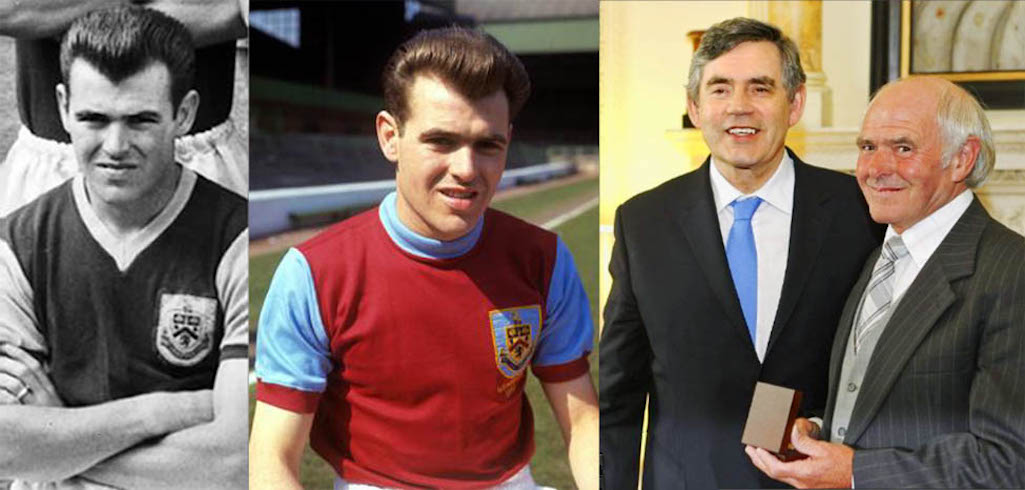
Footballing photos of John Connelly and receiving his belated World Cup medal from Prime Minister Gordon Brown in 2009

Footballing photos of John Connelly and receiving his World Cup medal in 2009

Footballing photos of John Connelly and receiving his belated World Cup medal
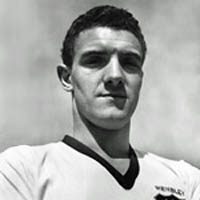
Other footballers of note from the Sutton district include Harry Parry of Bolton Wanderers, Bill Luckett of Southampton, John Quinn of Sheffield Wednesday, Ken Finney of Stockport County and Clock Face's Gary Owen who played for Manchester City and West Bromwich Albion. John Quinn had a lot in common with John Connelly. They were the same age, both fathers were miners and both attended St.Theresa's school in Sutton Manor.
There was also the brilliant Busby Babe Bill Foulkes, who came from Thatto Heath and played for St.Helens Town whilst working at Lea Green Colliery's Queen Pit. He played 679 games for Manchester United, mainly at centre back, and survived virtually unscathed from the Munich air disaster of February 6th 1958.
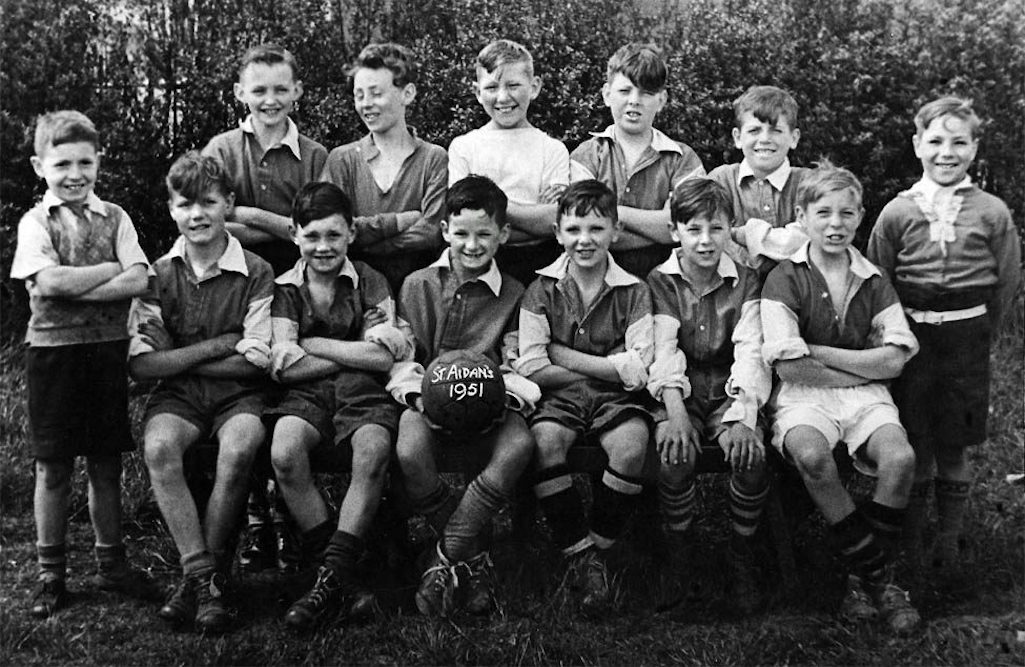
St. Aidan’s Clock Face 1951 - Contributed by James Prescott - View Version With Names

St. Aidan's of Clock Face pictured in 1951 - View Version With Names

St. Aidan’s of Clock Face in 1951
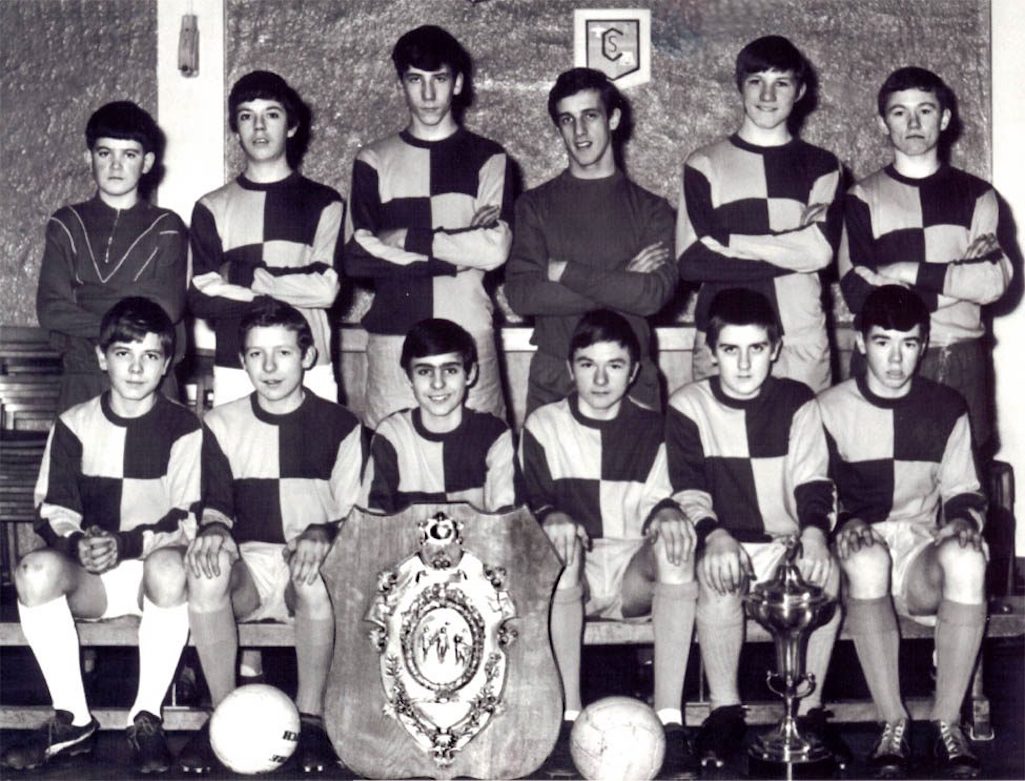
St.Cuthbert’s under 15s with St.Helens Schools Championship Shield - Contributed by Mel Moran - View Version With Names

St. Cuthbert's under 15s football team - View Version With Names

St. Cuthbert’s under 15s with the St.Helens Schools Championship Shield
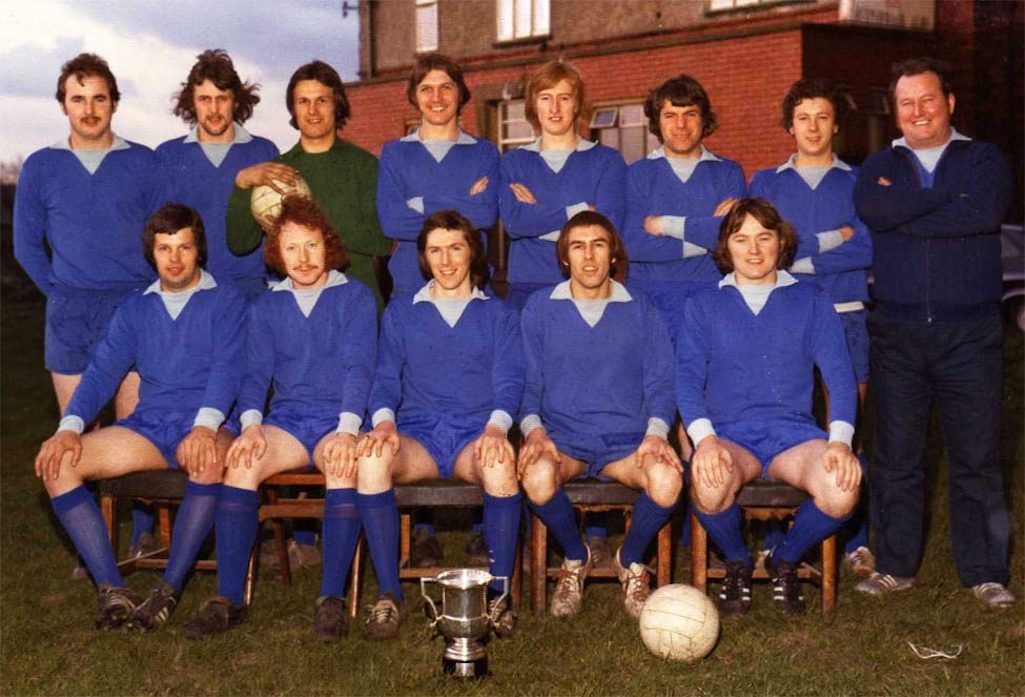
The Clock Face Recs round ball cup winning team from 1974/5 - Photograph contributed by Mel Moran

Clock Face Recs round ball cup winning team from 1974/5

Clock Face Recs from 1974/5
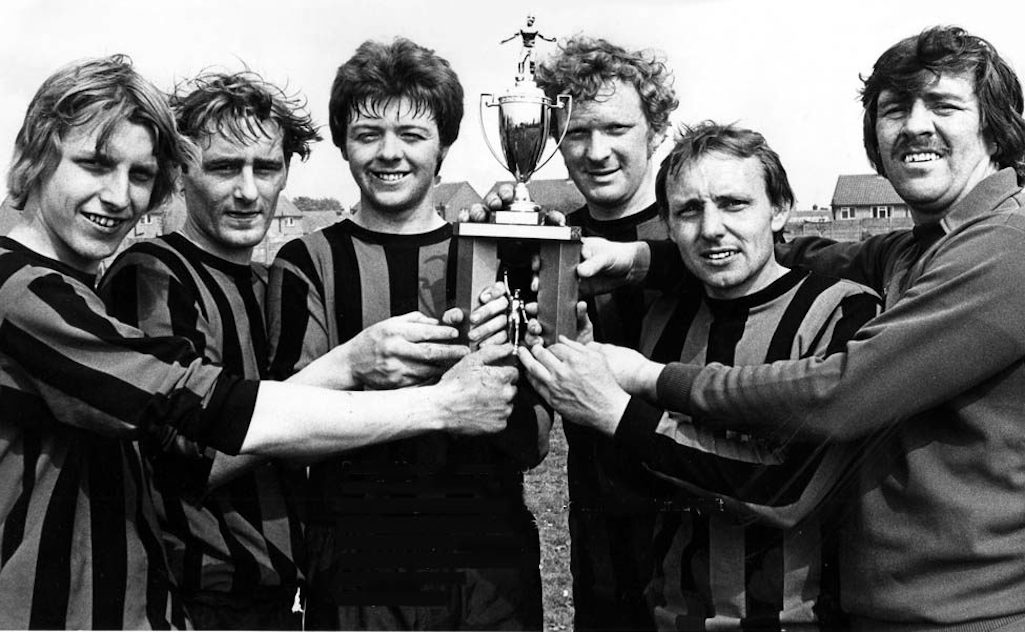
Sutton Manor pitmen who won the coal industry North West 5-a-side final - Contributed by Mel Moran

Sutton Manor pitmen who won the coal industry North West 5-a-side final

Sutton Manor pitmen won the coal industry North West 5-a-side final

Female football fixtures from the Liverpool Echo of December 11th 1918 featuring the Sutton Bond team

Female football fixtures from the Liverpool Echo of December 11th 1918

In April 1918 an inter-departmental knockout competition was held with the final played at the Sutton Commercial ground at St.Helens Junction between the Shell and Forgings departments. At the end of the war, with most women sacrificing their jobs in the munitions and other factories to the returning men, most female teams disappeared. There were a number of exceptions and the 'Sutton Glass Works' team reformed as St Helens Ladies AFC.
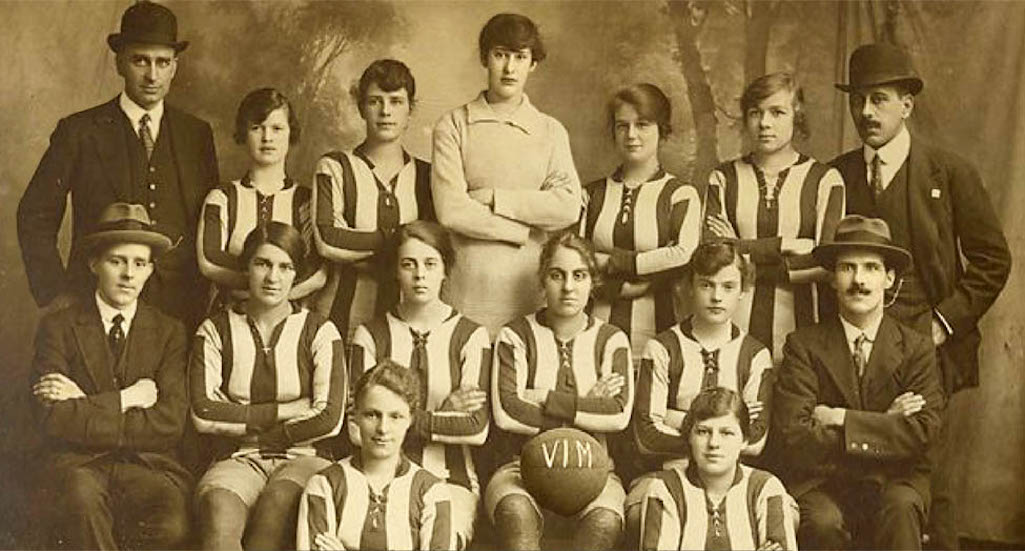
The Sutton Bond women's football team, who were often referred to as Sutton Glass Works

Sutton Bond women's football team, often referred to as Sutton Glass Works

Sutton Bond women's football team
Alice told her brother John about the invitation, who as Jack Woods played for Halifax Town in the Football League. He taught her how to play the game using a blackboard as a teaching aid. From Sutton Bond Alice transferred to St.Helens Ladies and after scoring a goal against Dick, Kerr’s side in 1919, the 20-year-old was recruited by their manager Alfred Frankland. Dick, Kerr's was a munitions factory in Preston that also manufactured locomotives and pontoon bridges. Their female football team was formed as a result of the workers enjoying kick-abouts during their lunch break. Dick, Kerr's (and St.Helens Ladies) raised huge sums for charity in matches played in front of tens of thousands of spectators.
In 1920 Alice was a member of the first British women’s football club to take part in an overseas tour when Dick, Kerr’s played in France. Later that year on Boxing Day, an astonishing 53,000 people crammed into Goodison Park – with over 10,000 outside unable to gain admission – in order to watch Alice and her team beat St.Helens Ladies 4 - 0.
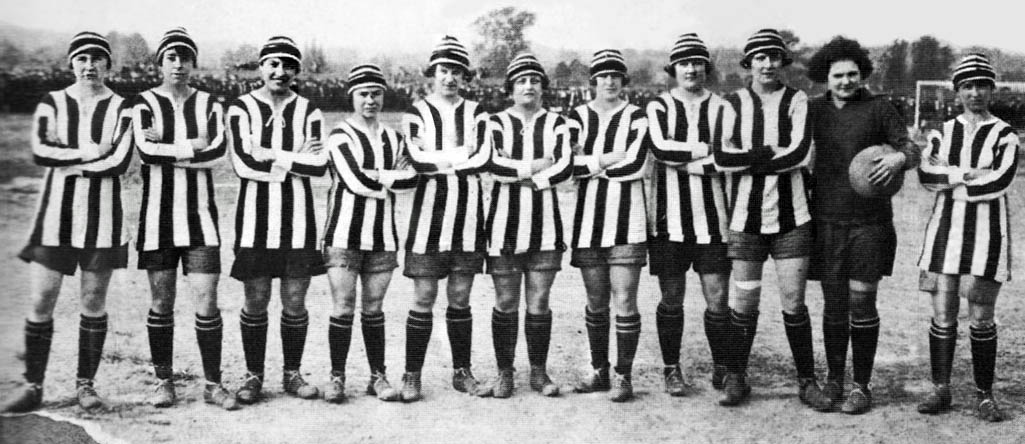
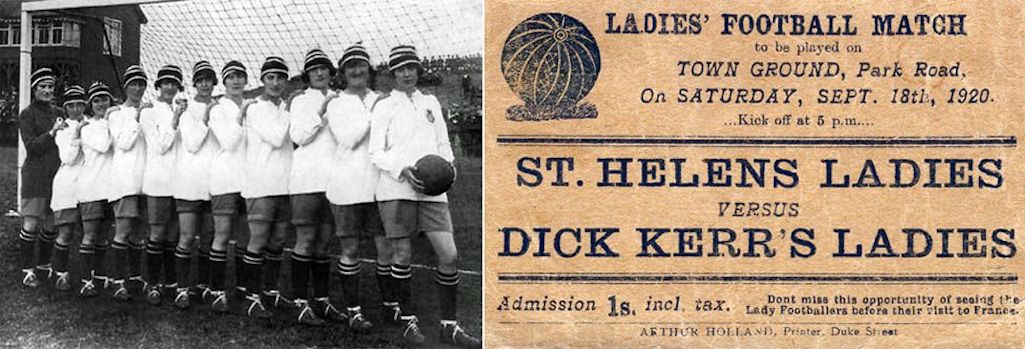
Left: Emma Grice is on the far left of this Dick, Kerrs team photograph, which is reproduced by the kind permission of Gail J. Newsham; Right: Ticket for St.Helens Ladies vs. Dick Kerr Ladies match in Park Road, St.Helens - Contributed by John Grice

Left: Emma Grice is on far left of this Dick, Kerrs team photo - reproduced by permission of Gail J. Newsham; Right: St.Helens Ladies vs. Dick Kerr Ladies

Emma Grice is pictured on the far left of this Dick, Kerrs team photograph
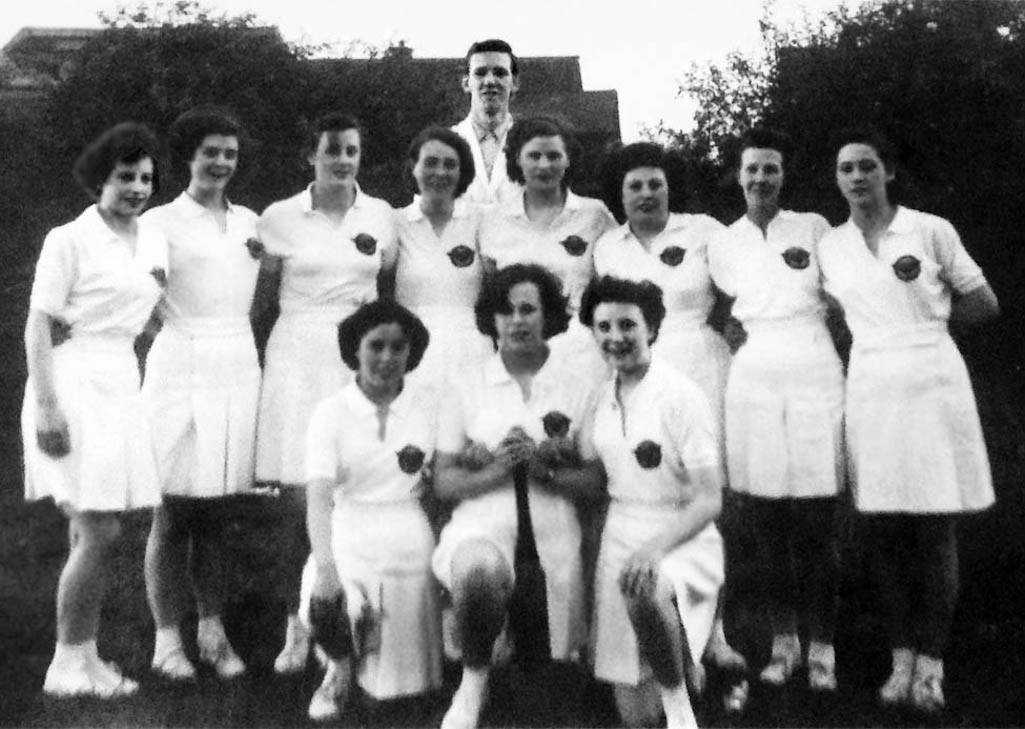


Back Row (L-R): J. R. Mercer; ?; J. Brotherton; H. Pearson; E. Roughsedge; E. Heaton; ?; H. Goss (umpire). Names by Geoff Chisnall

Front row (L to R): Jim Crehan, Graham Heyes, George Sheen (Capt.), Ian McCue, Bernie Smith and Bill McKeenan.
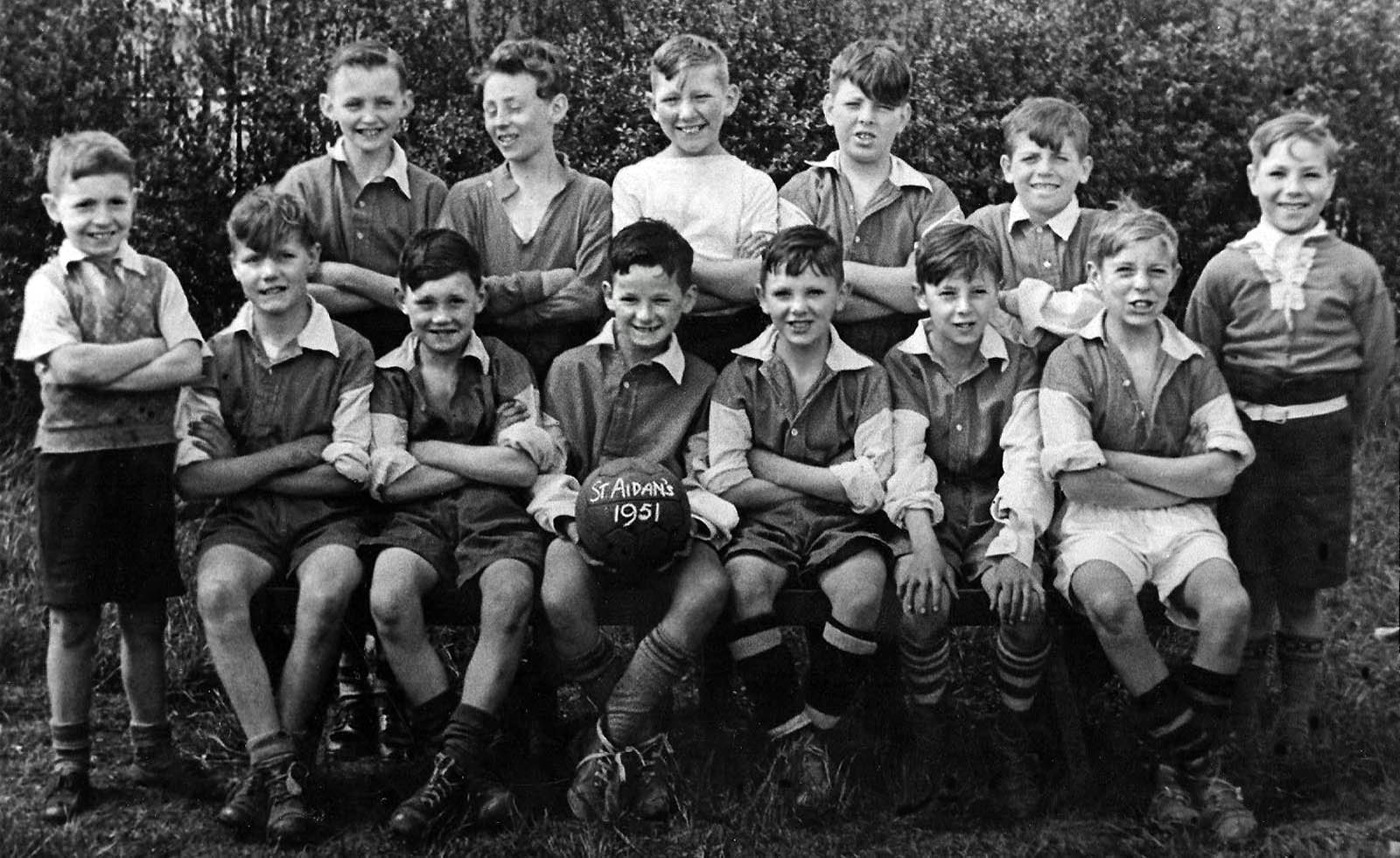
Front row (L to R): Ivor Tattum, Alan Benson, Ken Roberts, Teddy Hall, Kevin Carr ?, ?, ?


